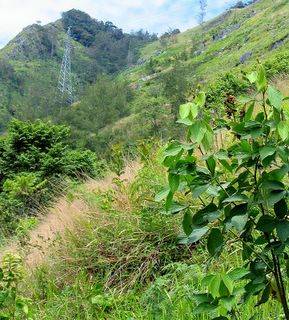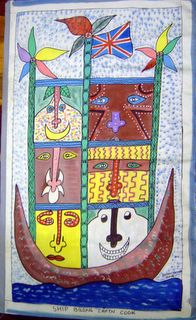Thursday 29 September 2005
Sunday 25 September 2005
the stars our destination
(also last weekend, had a big storm late afternoon with beautiful, strange, light)
but enough of goroka: tomorrow i fly out and up to Vanimo with the boy wonder. Check your maps: vanimo's on the north-west coast, nearing the border. Getting a visa there, and then tuesday it's due west - a new stamp in the passport, and adventures in the unknown...back in two weeks

last weekend i went to a friend's party. in the afternoon we had a bit of a cultural show in the backyard: one of the asaro mud men came and played. he stalked around the yard for a while, and we looked on appreciatively (yes, it was a bit strange) - but then he got each of us to wear one of the mud men masks and shadow-fight with him. weird experience; the mask is very heavy, and hot. no photos of me in mask; my culturally-appropriate rep remains intact
Thursday 22 September 2005
Tuesday 20 September 2005
show and tell
ok...and so here i begin to bore you. our lines of communication have been down since last wednesday, and when i found out that they were back and vibrating this evening, i got a bit excited and decided to post a large number of photos...these are all from the caving trip, mainly outside (these are the coffee beans drying on the road, stopping traffic from going any further; i'd say that we were the only traffic of the week). but don't worry - there are many more photos to fill the rest of your days: goroka show was on last week, independence, and there are also the normal bits and pieces from a busy weekend (and i met martin from "kantri bilong yumi", if anyone's seen it! very excited; he is fantastic fun, really cheeky sense of humour. highlight of my week.) anyway, back to the show:

after we left the caves, we had to hike back up the hill. finally we reached the top (the incline! the exhaustion), via a short cut which seemed to take a lot longer; then we had to wait for some sucker to take the long way round and pick up the car. even more villagers gathered round, lots of people to greet; hung out and chewed sugar cane; + stared out at the views. (my mind was a flat line at this stage.)
Sunday 11 September 2005
ship bilong PNG
(different faces represent different areas; the white face bottom right represents a Goroka man; I’m guessing he’s one of the asaro mud men)
The politics are ambiguous but I couldn’t resist this painting by Simon Gende, of Simbu.
I like to imagine it’s a re-dreaming of history. This time Papua New Guineans (see their distinctive noses!) man the ship and discover the new worlds. See how present they are: there’s no room for pasts or futures, so intent is the focus on the present, so absorbed are they in what is now. Their eyes meet your gaze directly, confident with their cultural markings of place. Ready.
PNG’s 30th anniversary of independence is coming up this weekend. I had forgotten this, until I wrote the above paragraph, and thought about the contrast between the optimism and strength in that picture and the uneasy air that surrounds talk of the commemoration.
It’s generally agreed that the state of PNG has degenerated, that in 30 years things (health services, education, governance, state institutions, environmental conditions and resources, safety) have gone “backwards” (if you like those linear, progressive models). There are malfunctions, breakdowns, failures; some things teeter permanently on the verge of collapse; others are unbearable – and yet must be borne. There are days when it seems that “PNG i bagarap”.
But somehow it never is. Whatever the analyses of the past and the predictions of the future; however dire or fantastic; there is a strong, kicking presence to the Papua New Guineans I work with, am friends with, move amongst. People are not devastated; they are not hopeless; they do not abandon the ship. Look again at the picture: there is no sign as to where the ship’s come from or where it’s going. There are no shadows. Instead people “face” the present, the here and now. There is something in this that represents what it is like here. It’s something more than the quality of durability: it’s living, a concentration on living itself.
It’s not that simple, of course. And today that attitude is not enough. But it’s also something that I’m learning from.
Tuesday 6 September 2005
close to home
i once read a voyeuristic blog that was all about someone spying on their neighbours - each post an update on something new seen/heard/exchanged. perhaps surprisingly, it made for great reading - they were evil mexicans i recall, constantly up to no good - but who ever has neighbours interesting enough to do this with? and who has the inclination to sit and trace their movements? whatever turns you on i suppose.
ggirl is nice if without intrigue. or so i thought. this afternoon when i came home there she was in the kitchen slicing open a pineapple that was, um, mine. she was so nonchalant ("Yum! I love ananas [pineapple]") that i didn't really know what to do except say "yeah".
not that i don't like sharing. (ok ok i'm the first-born, i hate sharing.) but: she has a shelf in the fridge with cheese and a jumbo jar of peanut butter. Yum.
Sunday 4 September 2005
Before reaching Kundiawa (the capital), we ducked left, down a road made of rocks, and bounced up and down for a few kilometres. There’s been no govt-funding for this road; several haus-lines (clans) in the area have banded together and made the road themselves. It’s actually one of the best unpaved roads I’ve been on(though, being unpaved, a few kms takes nearly an hour). We’re driving uphill, quite steeply; passing a few thatch-houses, a church, a few gardens, but mainly bush. There are goats – Seventh Day Adventists are in the area – and a few hens. There are about 2 000 people living around here, but they’re scattered and most don’t live near the road. There’s no school or aid post; you must travel out to get them.
Eventually we stop: coffee beans drying on white cloth in the middle of the road are the sign that we don’t need to go further; they are the x marking the spot. We get out and stretch, and as we stand people come trickling in from down the hill, from up the hill, from church, from bushes it seems; the five people standing around when we first arrive increase at least ten-fold. (I’m travelling with two locals, another highlander, a Sepik girl, two NZers, someone’s dad and a student from Oxford).
We wait around for a while. We are going to explore some caves which are the domain of three haus-lines; representatives from two are here, and someone has gone to get some from the final line.
Although I am the only volunteer amongst our group, we stress that we are all volunteers, not expats or tourists – and not tourist agents. Anyone whose done a bit of anthro knows about cargo cults; I think the term is a lazy label, but it remains a useful pointer for a type of mentality that is strong in parts of png: the belief that one day an abundance of “cargo” (material goods and money) will arrive and everyone will live happily ever-after. It stems from the first white people who appeared out of nowhere, bringing with them boxes and aeroplanes and boats of goods (and remember, whites first came to the highlands in the 1930s, not even 100 years ago). This pattern – many many things arriving out of nowhere – is a significant part of people’s worldview, and the appearance of whiteskins in your village is typically taken as a sign of its possibility. The tourism industry – which deserves to flourish, people and places are amazing and I urge everyone to come and spend there money here – is unfortunately tied up in this type of thinking: foreign tourists will come with money and goods and it will be gutpela sindaun, the good life in abundance – not after a few years, but immediately.
Our group are the first to come and see these caves. The visit is very important symbolically: if it goes well, people believe, all the tourists will come and life will be good. So we stress that we are all volunteers, that we do not conduct tours, that cargo will not be immediately forthcoming. Our bags with food are left in the car rather than brought out and shared (sharing is something I’d do in other contexts, but here it will confirm the goods-for-nothing and “whiteskins with their plenty” attitudes). At the end of the trip about 20 kina is given to the big men of the haus lines, and held up in the air, displayed to the whole community so that everyone knows how much has been given (often rumours spread and disputes begin because it’s believed that x squirreled away money from a common fund), and to make it clear that this is not cargo, it is a limited amount.
When reps from the three haus-lines are there, we begin to walk along a path to the caves. The path is beautiful: it is smooth, about a metre wide and lined with white rocks and carefully planted flowers – not just for 50m but 1km. It sounds funny as I type this, raving about a path, but it has been so carefully made: its inclines are never too steep, it is flat and broad and carefully tended: it must have been planned, taken months and many hands to do. Impressive.
The sun is shining merrily on and it is hot when we reach the cave entrance. About 40-50 people are walking with us; we all stop and one of the big men talks about the importance of this visit, before offering a prayer. Then we go inside. It’s big and cavernous; the floor is half rock half mud, so you’ve got to watch your step. Around the first bend are two knee-high mounds with half a (human) skull perched atop them. Villages used to place their dead in here (stopped since they become Christians); a high shelf hidden in shadow is pointed out where some skeletons remain.
We go deeper in; as usual I have impractical shoes and am worried about slipping, but a village woman sees my hesitancy and happily takes my hand and guides me to the rockier places (oxford isn’t so lucky and slips! Not that I am laughing). There are several pathways we could take, but we don’t have enough torches so we do a simple walk and go down to the underground river. I am surprised at how roomy it all is; I’d been expecting a tunnel and to feel oppressed. Instead, the space feels light and airy; it is like a cathedral in the dark.
**
We got back to Goroka around 4pm. For the last 10 minutes of the drive, we were caught in the afternoon downpour; Oxford could wash the mud off her pants, but that was about the only good thing about being in the back. I was wet and cold. And tired. Did I mention that I did all this after a big night out and about 4 hours sleep? S-T-A-M-I-N-A.
















